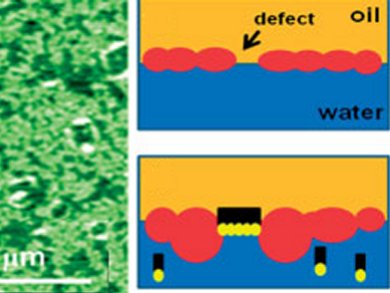Atomic Force Microscopy (AFM), a nanoscience imaging tool, has recently provided new information on the molecular formation of foods; this in turn meant solutions could be found to previously uncontrollable problems in food science.
Victor Morris and colleagues’, Institute of Food Research, Norwich, UK, review considers the opportunity to optimize food’s functional properties through the manipulation of its molecular structure. They write that by studying how the interfacial structures of foods behave on digestion, scientists can now propose routes for the rational design of processed food structures to control fat intake. By using AFM at the colloidal level, the interfacial formations can be manipulated in both processed and natural interactions.
This information can be used to aid the production of foods that promote health in old age and reduce the chance of the onset of chronic disease.
Image: Interfacial effects during digestion.
AFM image shows the growth of bile salt domains (black) inside a β-lactoglobulin protein (green) network.
Schematic pictures indicate how invasion of defects by surfactants (black and yellow)
squeezes the proteins (red), exposing them to degradation by enzymes.
© Society of Chemical Industry
- Atomic force microscopy as a nanoscience tool in rational food design
V. J. Morris, N. C. Woodward, A. P. Gunning,
J. Sci. Food Agric. 2011.
DOI: 10.1002/jsfa.4501


